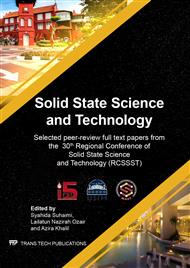[1]
X. Wu, X. Hong, J. Nan, Z. Luo, Q. Zhang, L. Li, H. Chen, K.S. Hui, Electrochemical double-layer capacitor performance of novel carbons derived from SAPO zeolite templates, Microporous and Mesoporous Materials. 160 (2012) 25-31.
DOI: 10.1016/j.micromeso.2012.04.013
Google Scholar
[2]
T. Matsui, S. Tanaka, Y. Miyake, Correlation between the capacitor performance and pore structure of ordered mesoporous carbons, Advanced Powder Technology. 24 (2013) 737-742.
DOI: 10.1016/j.apt.2013.03.003
Google Scholar
[3]
V.K. Saini, M. Andrade, M.L. Pinto, A.P. Carvalho, J. Pires, How the adsorption properties get changed when going from SBA-15 to its CMK-3 carbon replica, Separation and Purification Technology. 75 (2010) 366-376.
DOI: 10.1016/j.seppur.2010.09.006
Google Scholar
[4]
K.P. Gierszal, M. Jaroniec, T.W. Kim, J. Kim, R. Ryoo, High temperature treatment of ordered mesoporous carbons prepared by using various carbon precursors and ordered mesoporous silica templates. New J. Chem. 32 (2008) 981-993.
DOI: 10.1039/b716735k
Google Scholar
[5]
M. Kruk, M. Jaroniec, R. Ryoo, S.H. Joo, Characterization of ordered mesoporous carbons synthesised using MCM-48 silicas as templates. J. Phys. Chem B. 104 (2000) 7960-7968.
DOI: 10.1021/jp000861u
Google Scholar
[6]
A. Vinu, P. Srinivasu, M. Takahashi, T. Mori, V.V. Balasubramanian, K. Ariga, Controlling the Textural Parameters of Mesoporous Carbon Materials. Microporous and Mesoporous Materials. 100 (2007) 20-26.
DOI: 10.1016/j.micromeso.2006.10.008
Google Scholar
[7]
X. Wu, X. Hong, Z. Luo, K.S. Hui, H. Chen, J. Wu, K.N. Hui, L. Li, J. Nan, Q. Zhang, The effects of surface modification on the supercapacitive behaviors of novel mesoporous carbon derived from rod-like hydroxyapatite template. Electrochimica Acta. 89 (2013) 400-406.
DOI: 10.1016/j.electacta.2012.11.067
Google Scholar
[8]
H. Li, H. Xi, S. Zhu, Z. Wen, R. Wang, Preparation, structural characterization, and electrochemical properties of chemically modified mesoporous carbon. Microporous and Mesoporous Materials. 96 (2006) 357-362.
DOI: 10.1016/j.micromeso.2006.07.021
Google Scholar
[9]
F. Lufrano, P. Staiti, Influence of the surface-chemistry of modified mesoporous carbon on the electrochemical behavior of solid-state supercapacitors. Energy Fuels. 24 (2010) 3313-3320.
DOI: 10.1021/ef901447y
Google Scholar
[10]
P.X. Hou, H. Orikasa, T. Yamazaki, K. Matsuoka, A. Tomita, N. Setoyama, Y. Fukushima, T. Kyotani, synthesis of nitrogen-containing microporous carbon with a highly ordered structure and effect of nitrogen doping on H2O adsorption. Chem. Mater. 17 (2005) 5187.
DOI: 10.1021/cm051094k
Google Scholar
[11]
R. Ryoo, S.H. Joo, S. Jun, Synthesis of highly ordered carbon molecular sieves via template-mediated structural transformation. J. Phys. Chem. B. 103 (1999) 7743.
DOI: 10.1021/jp991673a
Google Scholar
[12]
D. Hulicova-Jurcakova, M. Seredych, G.Q. Lu, T.J. Bandosz, Combined effect of nitrogen and oxygen containing functional groups of microporous activated carbon on its electrochemical performance in supercapacitors. Adv. Funct. Mater. 19 (2009) 438-447.
DOI: 10.1002/adfm.200801236
Google Scholar
[13]
J. Chmiola, G. Yushin, R. Dash, Y. Gogotsi, Effect of pore size and surface area of carbide derived carbons on specific capacitance. J. Power Sources. 158 (2006) 765.
DOI: 10.1016/j.jpowsour.2005.09.008
Google Scholar
[14]
F. Lufrano, P. Staiti, Influence of the surface‒chemistry of modified mesoporous carbon on the electrochemical behavior of solid-state supercapacitors. Energy Fuels 24 (2010) 3313.
DOI: 10.1021/ef901447y
Google Scholar
[15]
H.M. Lee, H.G. Kim, S.J. Kang, S.J. Park, K.H. An, B.J. Kim, Effect of pore structures on electrochemical behaviors of polyacrylonitrile (PAN)-based activated carbon nanofibers. J. Ind. Eng. Chem. 21 (2015) 736.
DOI: 10.1016/j.jiec.2014.04.004
Google Scholar
[16]
E. Frackowiak, G. Lota, J. Machnikowski, C. Vix-Guterl, F. Béguin, Optimisation of supercapacitors using carbons with controlled nanotexture and nitrogen content. Electrochimica Acta. 51 (2006) 2209-2214.
DOI: 10.1016/j.electacta.2005.04.080
Google Scholar


